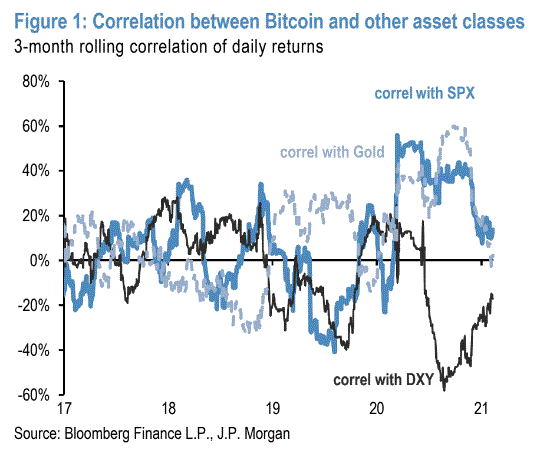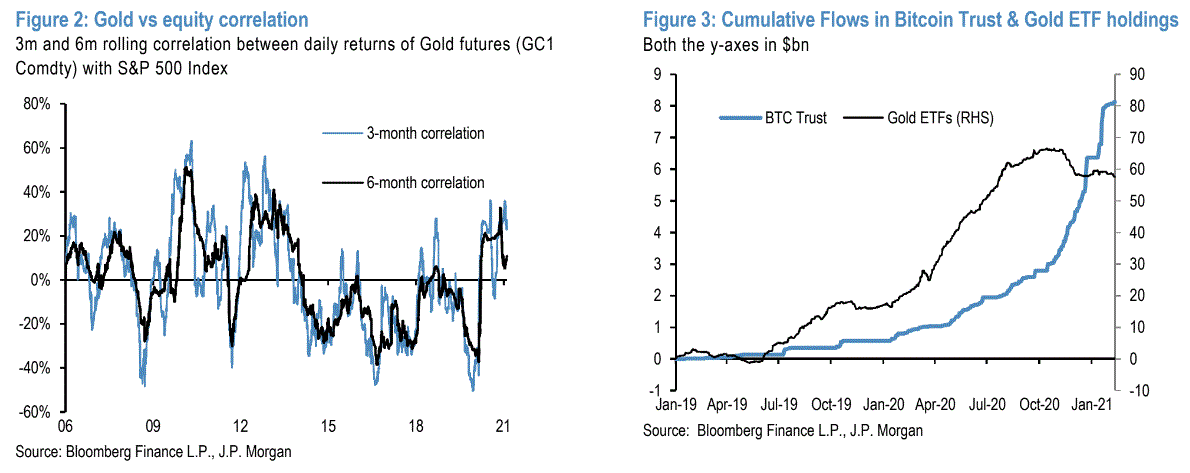JPM:
The virus crisis, by boosting money supply as well as demand for an “alternative” currency, has supported both gold and bitcoin over the past year. The older cohort preferred gold, while the younger cohorts preferred Bitcoin as an “alternative” currency. Both gold and bitcoin investment vehicles have experienced strong inflows over the past year, as both cohorts saw the case for an “alternative” currency. This simultaneous flow support has caused a change in the correlation pattern between Bitcoin and other asset classes, with a more positive correlation between bitcoin and gold but also between Bitcoin and the dollar (Figure 1). In addition, the simultaneous buying of US equities and Bitcoin by millennials has increased the correlation between bitcoin and S&P500 since last March, so it is more appropriate to characterize bitcoin as a “risk” asset rather than a “safe” asset, also given its still very high 70% realized volatility. To some extent, this is also true with gold. Gold’s correlation with the S&P500 has been predominantly positive over the past year and its volatility at close to 20% is more similar to that of equities than to currencies or bonds (Figure 2). In other words, both bitcoin and gold could be more characterized as “risk” rather than “safe” assets based on their behavior over the past year and investors’ preference for them is likely more of a reflection of a need for an “alternative” currency rather than a need fora “safe” asset or “hedge.”

In the second half of 2020, Bitcoin started receiving more support via corporate adoption, initially with Square and MicroStrategy and last October with Paypal. Paypal’s adoption of Bitcoin was a big step toward corporate support for Bitcoin, which in turn appears to have triggered demand for bitcoin by institutional investors such as family offices, hedge funds and even insurance companies such as MassMutual. Some of that institutional impulse into Bitcoin likely came at the expense of gold based on the more than $4bn of inflows into the Grayscale Bitcoin Trust and the more than $7bnof outflows from Gold ETFs since mid-October (Figure3). There is little doubt that this competition with gold as an “alternative” currency will continue over the coming years given that millennials will become over time a more important component of investors’ universe and given their preference for “digital gold” over traditional gold. Considering how big the financial investment into gold is, any such crowding out of gold as an “alternative” currency implies big upside for Bitcoin over the long-term. As we had mentioned previously in the Oct 23rdFlows & Liquidity, “Bitcoin’s competition with gold,” private gold wealth is mostly stored via gold bars and coins, the stock of which, excluding those held by central banks, amounts to 42,600 tonnes or $2.7trn including gold ETFs. Mechanically, the market cap of Bitcoin at $900bn currently would have to rise by 3x from here, implying a theoretical Bitcoin price of $146k, to match the total private sector investment in gold via ETFs bars and coins.


